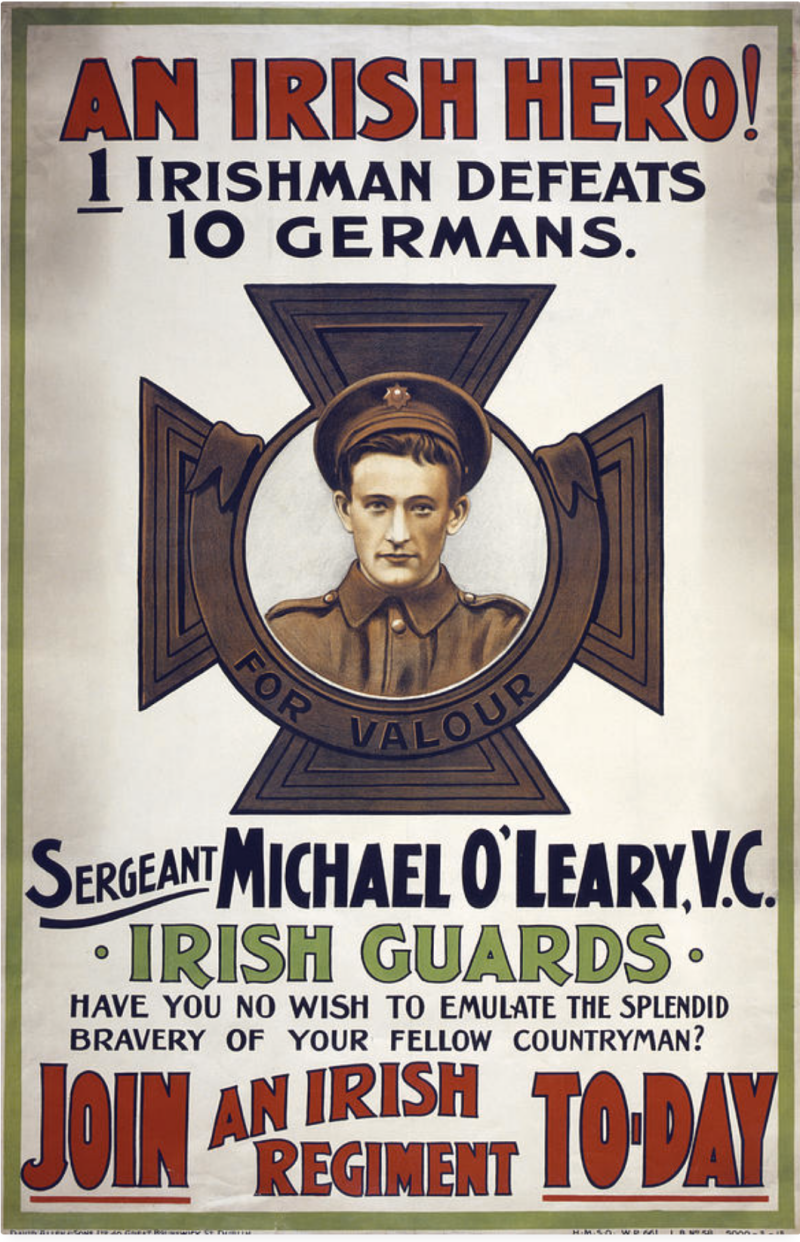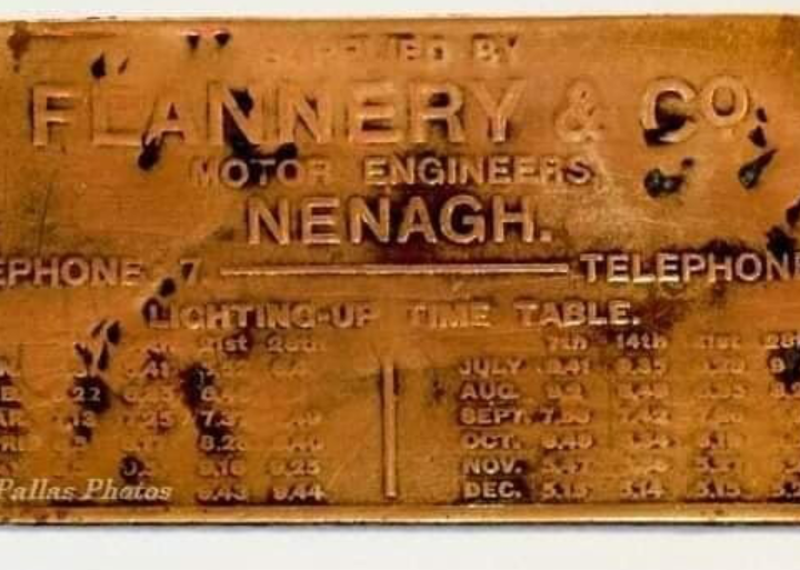STEPHEN FLANNERY
Stephen Flannery was one of those self made men who recognise a good opportunity when it arises and get in at the outset. A natural entrepreneur, he was born 30/01/1870, in Spout Road to Edward Flannery and Anne Canny. Edward was a labourer.
Stephen first comes to our attention on 18/06/1889 when he’s brought in front of Nenagh Petty Sessions for using abusive language in Spout Road, designed to provoke a Breach of the Peace. Stephen would be no stranger to Nenagh Court house.
Stephen married his first wife Margaret Shanahan on 29/04/1891. He states he is a Butler as an occupation. Unfortunately the marriage is short lived and Margaret dies in childbirth on 29/09/1894. Margaret’s Death registration also clarifies Stephen’s occupation as it states he lives in Barrack St and he works as a Club Steward. His alternative address is given as Castle St and indicates that he is employed by the North Tipperary Club, beside Frederick Day’s Stationers in Castle St.
On 27/02/1897, Stephen marries his second wife, bakers daughter Mary Flannery. He is now working as a Vanman.
In 1901, Stephen has applied for a patent for a new type of combined gears to be used on Bicycles. The following year on 11/02/1902, Stephen organises and caters for a Ball for the Nenagh Commercial Tradesmen. This was held in the Courthouse. The Ball commenced at 10 pm, included supper and didn’t finish until 06..00 a.m. the following day. By all accounts a great success.
In the early days of motoring it was customary to print the names of those lucky few who held driving licences or owned a vehicle. By February 1905 Stephen is the proud owner of that rare early beast, a motor cycle. He is also one of the few in North Tipperary that hold a Driving Licence. Curiously enough, it is this notice that informs us that the letters ‘FI’ would denote registered in North Tipperary.
28/04/1906 see’s Stephen back in the Petty Sessions again, this time for not having a dog licence. The following February we know that Stephen has now moved to Gaol St as he’s brought before Magistrates for not sending his children to school.
We know he has moved to 43 Castle St by 1908 as he has applied for a licence to store and sell Petroleum. He’s still in trouble with the authorities though as again he’s in front of the Magistrates, this time for not having the children vaccinated. He finishes the year being put before Moneygall Sessions for not having a tail light. It must have been a slow news day as this is recorded in the Leinster Reporter 19/12/1908.
July 1909 see’s Stephen and fellow bicycle trader Mr Pierce standing before Nenagh Town Council discussing the inadvisability of allowing cheap sales of Bicycles in the Townhall by an English Firm. This firm who claimed they were from Birmingham were not even on the local Birmingham Trade Directory.
Stephen also pointed out that there was a ruling on the Town Statutes that forbade the use of the Town Hall as a bazaar or Market to sell goods that would be detrimental to the wellbeing of local traders. Furthermore these goods were of a foreign nature and not up to the quality locally found. The Council voted in favour of Stephens objections citing the previous statute as sufficient grounds.
Everything is reasonably quiet for a few years. We see Stephen trading away at 43 Castle St, selling his bicycles and annually renewing his Petroleum Licence. Then Stephen is back in court again….this time for non payment of rent in 1913.
Bridget O’Brien was the owner of 43 and 44 Castle St. Bridget lived next door at 44. The rent on 43 was payable in advance half yearly. Bridget in turn would pay rent on the properties but not in advance, only on the due date. This meant that Stephens Rent sat in Bridget’s account for six months before being paid to the landlord. It meant Bridget was earning interest on this money and Stephen objected to this use of his money. Stephen suggested he will pay the money in advance if Bridget would return 50% of the interest earned. An agreement was made between the two that Stephen would buy the lease on 43 outright.
The matter subsequently was brought to the attention of the Town Tenants League as other tenants found that they were subject to the same terms and Stephen was invited to address it.
Later that year, Stephen takes out an advert referring to himself as the self styled “Flannery - The Cycle Man’. Definitely no stranger to self promotion.
1914 comes and Stephen is once again is in court for having no lights on his car on a Summers evening. The case is dismissed without prejudice.

Castle St with Flannery's at 43 advertising Dunlop Motor Tyres
In 1915, a photographer comes to Nenagh and records an image of the town from Upper Castle St. We get a great view of Stephens premises at 43 Castle St. On a giant wedge shaped billboard he advertises Dunlop Motor Tyres. On the front window of the shop he proudly displays a poster of Michael O’Leary of the Irish Guards who had been awarded a V.C. for heroic exploits capturing machine-gun posts on the Frontline. O’Leary had been gazetted 16/02/1915 so we know the image dates was taken after this date.
By 1918 Stephen is now selling Tractors. This is newsworthy enough to be reported in the Leinster Reporter. Unfortunately Stephen is back in court for non-attendance at school of his children. Things continue in this manner, Stephen is a natural and popular business man. When he started out he had £1000 to invest in his business. He managed to secure similar investments in his business from two others, no doubt helped by the contacts he made during the time he spent working in the North Tipperary Club. He had repaid his investors in full and was on the way to becoming quite a successful Tradesman in his own right.
…..and then came the fateful night of 08/03/1922
Stephen was returning from Dublin by G.S.W.R. train. He had been at a motor trade conference in Dawson St where Stephen and his colleagues had formed the new Irish Motor Trade Association that day and had great success. He was returning to Nenagh with a few other local Nenagh business men. They were all in a jovial mood and good spirits.
In those days it was common practice to have those passengers for the Nenagh Branch Line to occupy the last three carriages. These would separate from the main express which would continue along its way to Cork. The process was known as slipping. The slip coaches would continue engineless, powered by the momentum of the main Express and freewheel down to Ballybrophy where it would be stopped by a guard in the attached brake-van. This meant the Express didn’t need to stop at Ballybrophy and could continue straight through.
The passengers would then transfer to the smaller branch line train and continue their journey.
On this occasion however, the brakes didn’t engage completely and the slip coaches caught up with the main express and ploughed into the back of the train. The express had been slowing for the approach to Ballybrophy.
Stephen was killed immediately. The first half of the slip coach was reduced to splinters. There were a number of injuries, eight seriously, some amongst the Nenagh contingent but Stephen was the only fatality. A doctor on the train saw to the injured and a priest was present to reassure others. Some of the injured were ferried to Roscrea or to home if it was nearby. Two IRA men were on board the train and took charge of the rescue operation, Commandant A Cooney of Ballyphillip and Lieutenant Ryan.
A breakdown team was summoned from Limerick to clear the line. The main train continued on its way while Stephens body was transferred to the Branch line train for Nenagh. A large crowd waited at Nenagh, news of the crash having been phoned through.
Upon reaching Nenagh at 21.00, Stephen was stretchered into the waiting room. The local I.R.A. police were in attendance to prevent people overcrowding the station. In the waiting Room, Stephen was examined by Dr Courtney and two others and coffined and conveyed to St Mary’s R.C. He was buried the following day in Lisboney after the Celebration of a High Mass.
The inquest was held the following day under James O’Brien, Coroner for North Tipperary. It was found that Stephen had died of a broken neck and lacerations to the brain. There were representatives of the Railway Company present but none of the Guardsmen who had actually been on the train. Mr O’Brien refused to adjourn for the GSWR’s benefit. He found that Stephen had died due to a Railway Accident.
But the story dosen’t end here….
On 14/12/1922, Mary brought a case against GSWR for loss of potential earnings. Under the Campbell Act, a survivor could claim for pecuniary loss based on reasonable expectations of earnings of the person killed.
The Railway company admit negligence but denied any liability. The company argued that no loss or damage was suffered.
The widow had been left with 10 children, none of whom were earning. Stephen had started at the bottom and grown his business which earned in excess of £800 a year. This added to land which earned £200 per annum. In no time at all, had he lived he could reasonably have expected up to £3000 a year. This was quite a significant sum for the time.
The jury found in favour of Stephens wife. The family was awarded £9000 in damages - £3000 to Mary and the remainder to be divided amongst the children according to seniority. They were also awarded costs. Even in death, Stephen came out with a profit…..

Death Registration 08/03/1922 Abbeyleix

Stephen Flannery

Cork Examiner 03/10/1901 - Patent

Midland Tribune 22/02/1902 - Ball

Leinster Reporter 19/12/1908

Flannery's window

The poster in Flannerys window 1915

Staffordshire Sentinel 09/03/1922

Leinster Reporter 23/12/1922

The man himself .....1920


Trader plate from Flannery's, Nenagh
(Thank you to Rob Toohey for the use of his images.)
Create Your Own Website With Webador